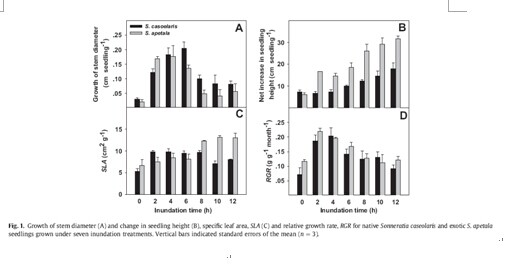Luzhen Chen, Nora F.Y. Tam, Wenqing Wang, Yihui Zhang, Guanghui Lin.Estuarine, Coastal and Shelf Science,2013. 117:22-28.Sonneratia apetalaBuch.-Ham., an introduced mangrove species from Bangladesh, has been popularlyused in mangrove afforestation in China for more than 20 years. Whether there is an overlap in nichebetween this exotic species and native mangrove species is still unknown. The purpose of this study is toevaluate differences in growth and physiological responses to tidal inundation between the exoticS. apetalaand its congeneric species in China,Sonneratia caseolaris. A set of tidal tanks was used tosimulate different tidal ranges by controlling different inundation periods (0, 2, 4, 6, 8, 10, 12 h). Both theinundation period and species showed significant effects on almost all morphological, growth andphysiological parameters measured; however, there were no significant differences between the twospecies in the responses of these parameters to the inundation period, except for specific leaf area (SLA)and light compensation point (LCP). Significant increases in SLA under the long inundation periods(10, 12 h) for the exotic, but not for the native species, indicate that the exotic one tended to increase itsleaf area for assimilation. Thus, the exoticS. apetalaseedling exhibited phenotypic plasticity to tidalinundation similar that of the native,S. caseolaris, which suggests that the exotic and nativeSonneratiaspecies will occupy a similar niche along the entire tidal range.

返回

